Investigation on a Shutdown Control Strategy with Residual Oxygen Rapid Elimination for Proton Exchange Membrane Fuel Cell System
Abstract
:1. Introduction
2. Experimental
2.1. The PEMFC Stack Parameters and Experimental Test Platform
2.2. Procedure of the Experimental Test
3. Results and Discussion
3.1. Impact of the Fuel Cell Drop Rate of the Discharge Current during Shutdown Process
3.2. Impact of the Auxiliary Load Resistance on Shutdown Process
3.3. Comparison of Shutdown Strategy of the PEMFC System before and after Optimization
4. Conclusions
Author Contributions
Funding
Institutional Review Board Statement
Informed Consent Statement
Data Availability Statement
Conflicts of Interest
References
- Herc, L.; Pfeifer, A.; Duić, N. Optimization of the possible pathways for gradual energy system decarbonization. Renew. Energ. 2022, 193, 617–633. [Google Scholar] [CrossRef]
- Sun, C.; Zhang, H. Review of the Development of First-Generation Redox Flow Batteries: Iron-Chromium System. ChemSusChem 2022, 15, e202101798. [Google Scholar] [CrossRef] [PubMed]
- Kim, J.; Huh, C.; Seo, Y. End-to-end value chain analysis of isolated renewable energy using hydrogen and ammonia energy carrier. Energ. Convers. Manag. 2022, 254, 115247. [Google Scholar] [CrossRef]
- Huang, Z.; Shen, J.; Chan, S.H.; Tu, Z. Transient response of performance in a proton exchange membrane fuel cell under dynamic loading. Energ. Convers. Manag. 2020, 226, 113429. [Google Scholar] [CrossRef]
- Zhu, D.; Ma, T.; Yang, Y. Optimization and application of the distribution of relaxation times based on characteristic frequency resolution and hyperparameters. J. Power Sources 2022, 545, 231955. [Google Scholar] [CrossRef]
- Zhu, D.; Yang, Y.; Pei, F.; Ma, T. High-precision identification of polarization processes of distribution of relaxation times by polarization curve model for proton exchange membrane fuel cell. Energ. Convers. Manag. 2022, 268, 115994. [Google Scholar] [CrossRef]
- Wu, J.; Yuan, X.Z.; Martin, J.J.; Wang, H.Z.; Hang, J.; Shen, J.; Wu, S.; Merida, W. A review of PEM fuel cell durability: Degradation mechanisms and mitigation strategies. J. Power Sources 2008, 184, 104–119. [Google Scholar] [CrossRef]
- Zhao, J.; Li, X. A review of polymer electrolyte membrane fuel cell durability for vehicular applications: Degradation modes and experimental techniques. Energ. Convers. Manag. 2019, 199, 112022. [Google Scholar] [CrossRef]
- Pei, P.; Chang, Q.; Tang, T. A quick evaluating method for automotive fuel cell lifetime. Int. J. Hydrogen Energy 2008, 33, 3829–3836. [Google Scholar] [CrossRef]
- Zhang, T.; Wang, P.; Chen, H.; Pei, P. A review of automotive proton exchange membrane fuel cell degradation under start-stop operating condition. Appl. Energy 2018, 223, 249–262. [Google Scholar] [CrossRef]
- Ma, T.; Zhu, D.; Xie, J.; Lin, W.; Yang, Y. Investigation on a parking control strategy for automotive proton exchange membrane fuel cell. Fuel Cells 2021, 21, 390–397. [Google Scholar] [CrossRef]
- Stevens, D.A.; Hicks, M.T.; Haugen, G.M.; Dahn, J.R. Ex Situ and In Situ Stability Studies of PEMFC Catalysts. J. Electrochem. Soc. 2005, 152, A2309–A2315. [Google Scholar] [CrossRef]
- Guilminot, E.; Corcella, A.; Charlot, F.; Maillard, F.; Chatenet, M. Detection of Ptz+ Ions and Pt Nanoparticles Inside the Membrane of a Used PEMFC. J. Electrochem. Soc. 2007, 154, B96–B105. [Google Scholar] [CrossRef]
- Jung, G.-B.; Chuang, K.-Y.; Jao, T.-C.; Yeh, C.-C.; Lin, C.-Y. Study of high voltage applied to the membrane electrode assemblies of proton exchange membrane fuel cells as an accelerated degradation technique. Appl. Energy 2012, 100, 81–86. [Google Scholar] [CrossRef]
- Lamibrac, A.; Maranzana, G.; Lottin, O.; Dillet, J.; Mainka, J.; Didierjean, S.; Thomas, A.; Moyne, C. Experimental characterization of internal currents during the start-up of a proton exchange membrane fuel cell. J. Power Sources 2011, 196, 9451–9458. [Google Scholar] [CrossRef]
- Tang, H.; Qi, Z.; Ramani, M.; Elter, J.F. PEM fuel cell cathode carbon corrosion due to the formation of air/fuel boundary at the anode. J. Power Sources 2006, 158, 1306–1312. [Google Scholar] [CrossRef]
- Yu, Y.; Tu, Z.; Zhang, H.; Zhan, Z.; Pan, M. Comparison of degradation behaviors for open-ended and closed proton exchange membrane fuel cells during startup and shutdown cycles. J. Power Sources 2011, 196, 5077–5083. [Google Scholar] [CrossRef]
- Oh, H.-S.; Oh, J.-G.; Haam, S.; Arunabha, K.; Roh, B.; Hwang, I.; Kim, H. On-line mass spectrometry study of carbon corrosion in polymer electrolyte membrane fuel cells. Electrochem. Commun. 2008, 10, 1048–1051. [Google Scholar] [CrossRef]
- Genorio, B.; Strmcnik, D.; Subbaraman, R.; Tripkovic, D.; Karapetrov, G.; Stamenkovic, V.R.; Pejovnik, S.; Markovic, N.M. Selective catalysts for the hydrogen oxidation and oxygen reduction reactions by patterning of platinum with calix [4] arene molecules. Nat. Mater. 2010, 9, 998–1003. [Google Scholar] [CrossRef]
- Ishigami, Y.; Takada, K.; Yano, H.; Inukai, J.; Uchida, M.; Nagumo, Y.; Hyakutake, T.; Nishide, H.; Watanabe, M. Corrosion of carbon supports at cathode during hydrogen/air replacement at anode studied by visualization of oxygen partial pressures in a PEFC—Start-up/shut-down simulation. J. Power Sources 2011, 196, 3003–3008. [Google Scholar] [CrossRef]
- Eom, K.; Jo, Y.Y.; Cho, E.; Lim, T.-H.; Jang, J.H.; Kim, H.-J.; Hong, B.K.; Lee, J.H. Effects of residual oxygen partial pressure on the degradation of polymer electrolyte membrane fuel cells under reverse current conditions. J. Power Sources 2012, 198, 42–50. [Google Scholar] [CrossRef]
- Oyarce, A.; Zakrisson, E.; Ivity, M.; Lagergren, C.; Ofstad, A.B.; Bodén, A.; Lindbergh, G. Comparing shut-down strategies for proton exchange membrane fuel cells. J. Power Sources 2014, 254, 232–240. [Google Scholar] [CrossRef]
- Yu, Y.; Wang, G.; Tu, Z.; Zhan, Z.; Pan, M. Effect of gas shutoff sequences on the degradation of proton exchange membrane fuel cells with dummy load during startup and shutdown cycles. Electrochim. Acta 2012, 71, 181–193. [Google Scholar] [CrossRef]
- Lin, R.; Liu, D.; Xia, S.; Ma, T.; Dutruel, B. Stack shut-down strategy optimisation of proton exchange membrane fuel cell with the segment stack technology. Int. J. Hydrogen Energy 2020, 45, 1030–1044. [Google Scholar] [CrossRef]
- Schneider, I.A.; von Dahlen, S. Start-Stop Phenomena in Channel and Land Areas of a Polymer Electrolyte Fuel Cell. Electrochem. Solid-State Lett. 2011, 14, B30–B33. [Google Scholar] [CrossRef]
- Kim, J.H.; Cho, E.A.; Jang, J.H.; Kim, H.J.; Lim, T.H.; Oh, I.H.; Ko, J.J.; Son, I.-J. Development of a Durable PEMFC Start-Up Process by Applying a Dummy Load- II. Diagnostic Study. J. Electrochem. Soc. 2010, 157, B118–B124. [Google Scholar] [CrossRef]
- Linse, N.; Scherer, G.G.; Wokaun, A.; Gubler, L. Quantitative analysis of carbon corrosion during fuel cell start-up and shut-down by anode purging. J. Power Sources 2012, 219, 240–248. [Google Scholar] [CrossRef]
- Kim, J.H.; Cho, E.A.; Jang, J.H.; Kim, H.J.; Lim, T.-H.; Oh, I.-H.; Ko, J.J.; Oh, S.C. Development of a Durable PEMFC Startup Process by Applying a Dummy Load- I. Electrochemical Study. J. Electrochem. Soc. 2009, 156, B955–B961. [Google Scholar] [CrossRef]
- Kim, H.-J.; Lim, S.J.; Lee, J.W.; Min, I.-G.; Lee, S.-Y.; Cho, E.; Oh, I.-H.; Lee, J.H.; Oh, S.-C.; Lim, T.-W.; et al. Development of shut-down process for a proton exchange membrane fuel cell. J. Power Sources 2008, 180, 814–820. [Google Scholar] [CrossRef]
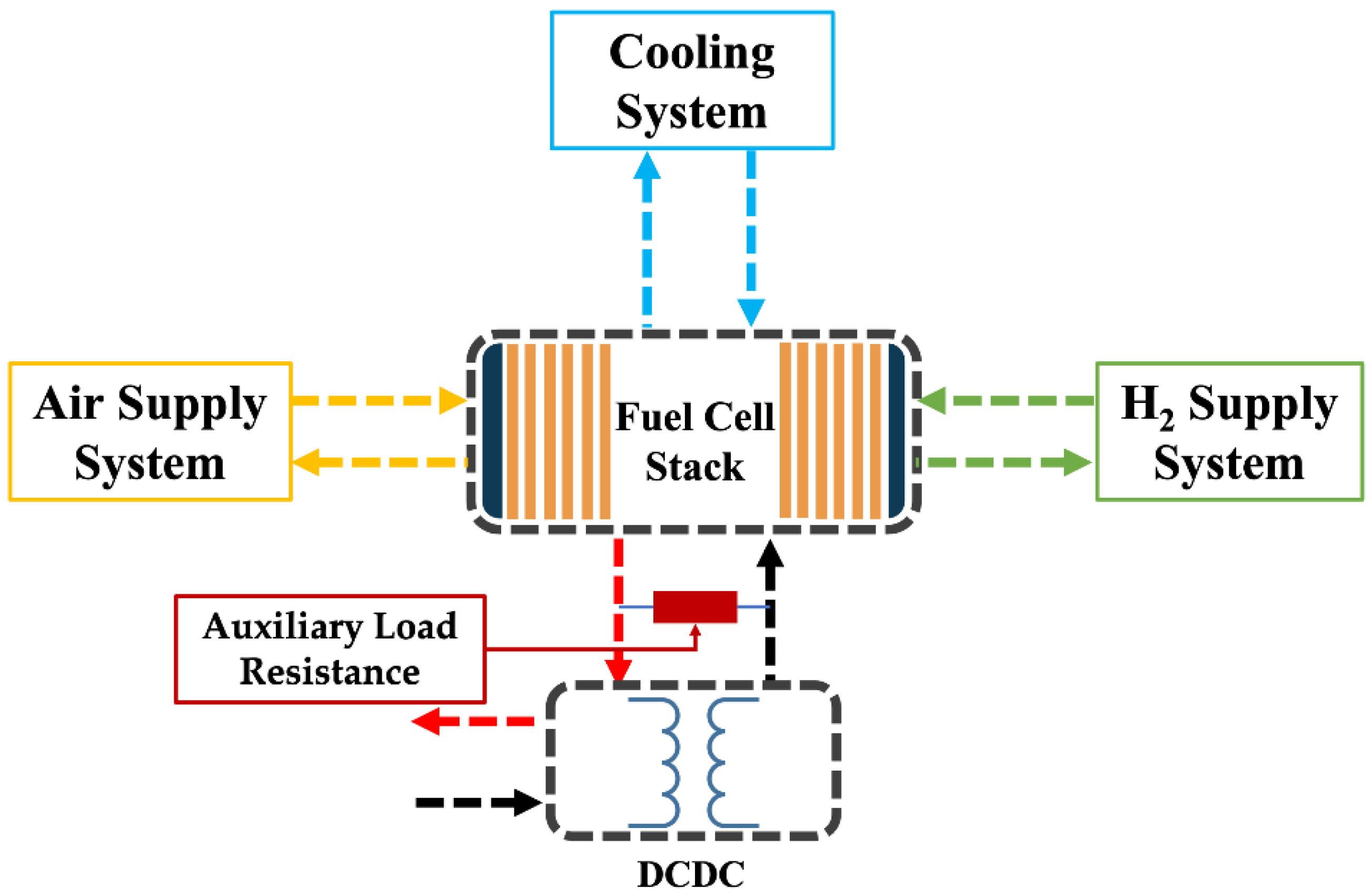
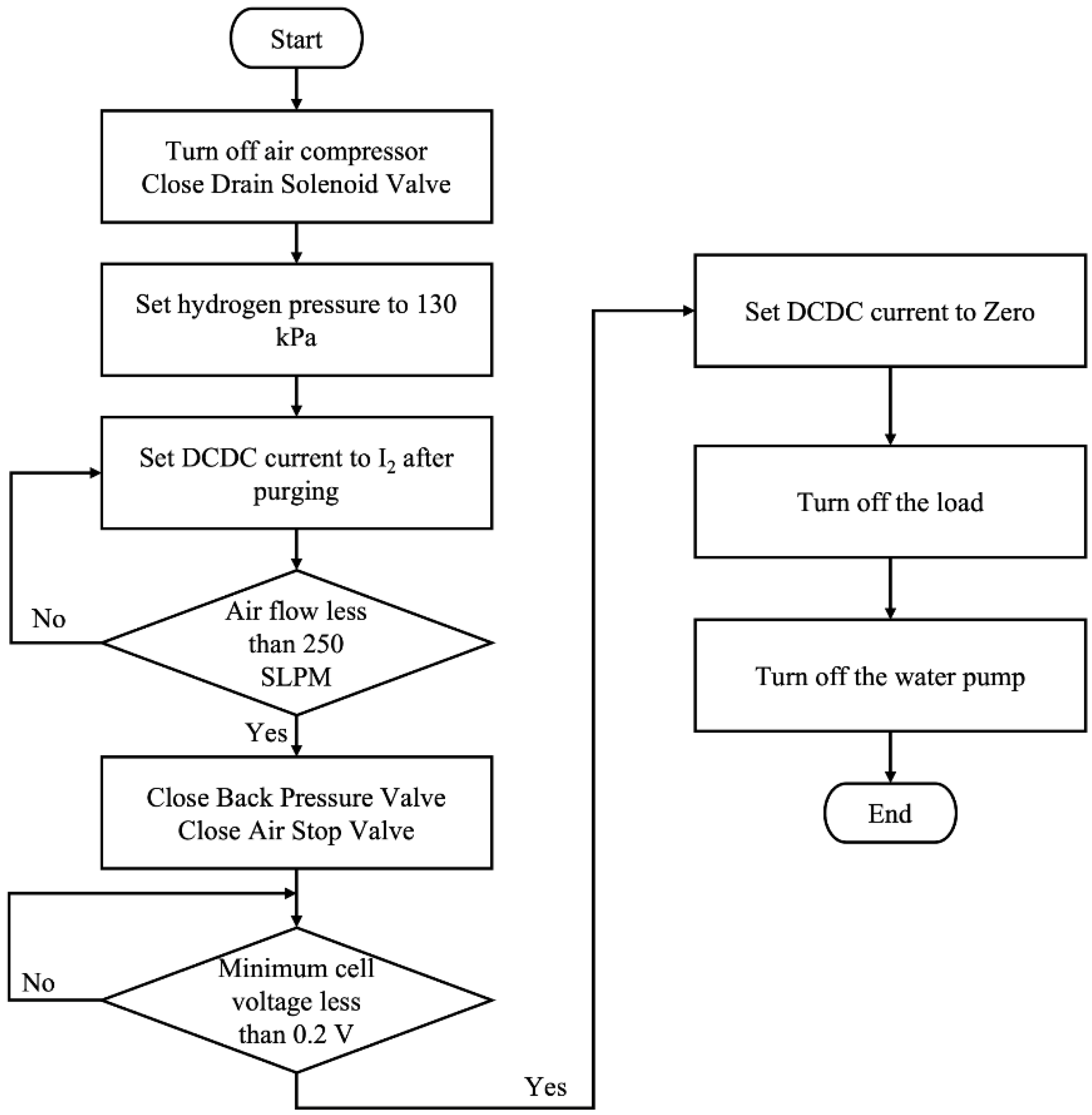
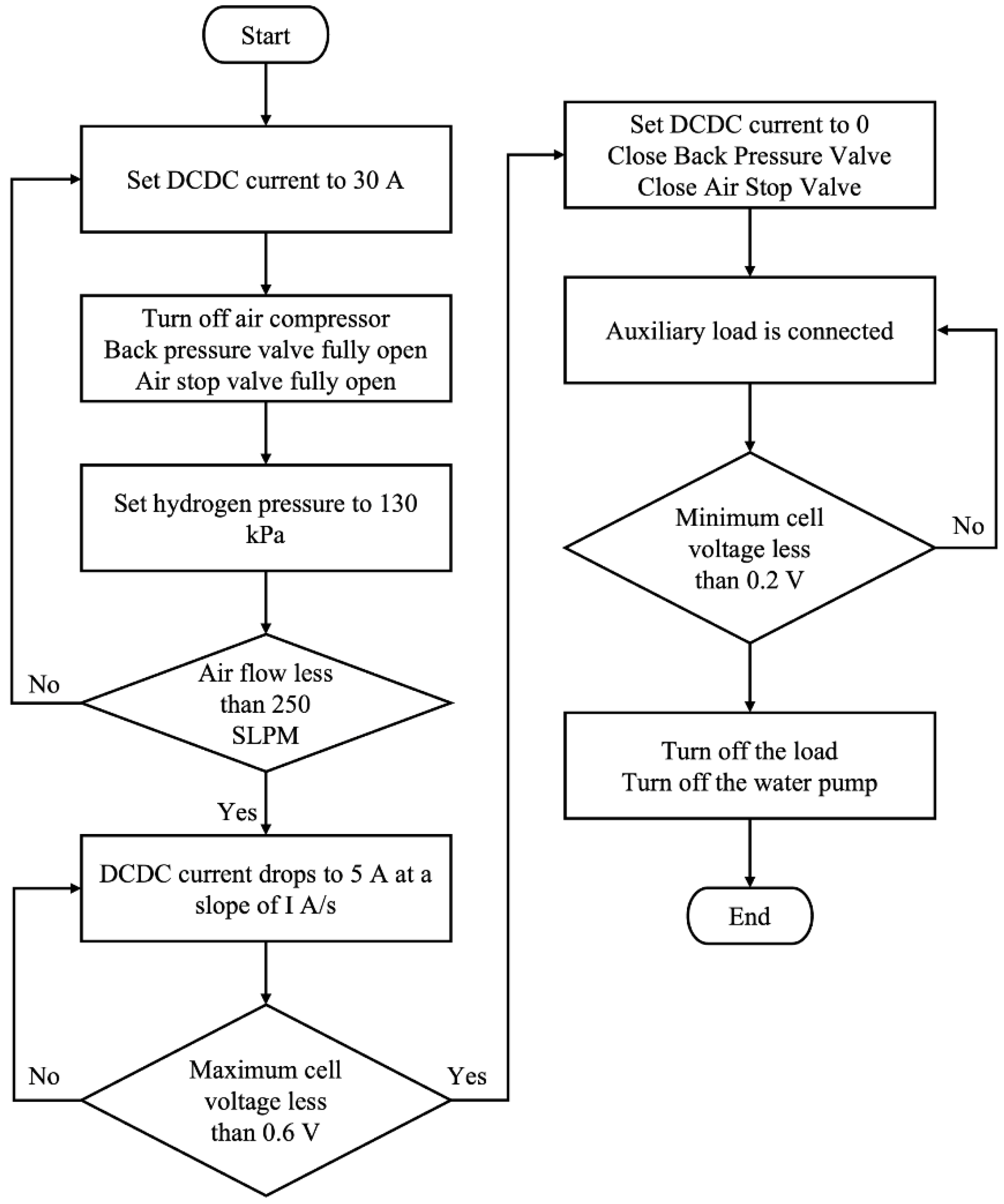

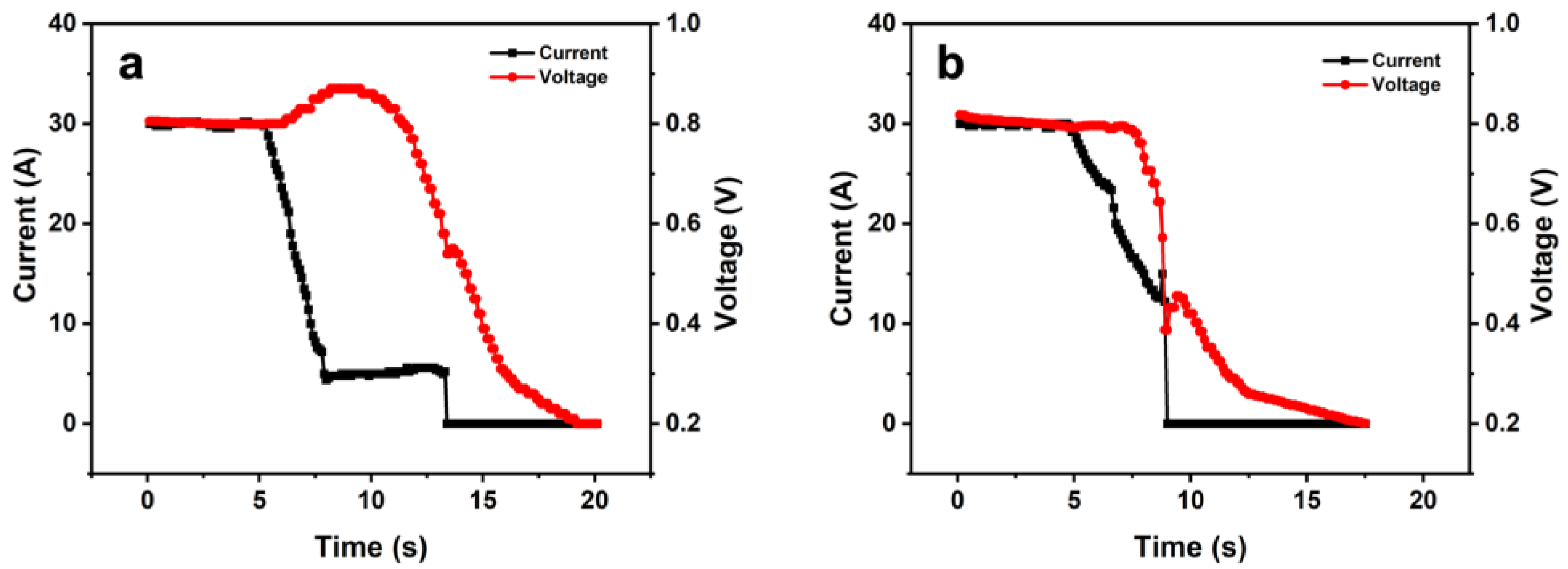
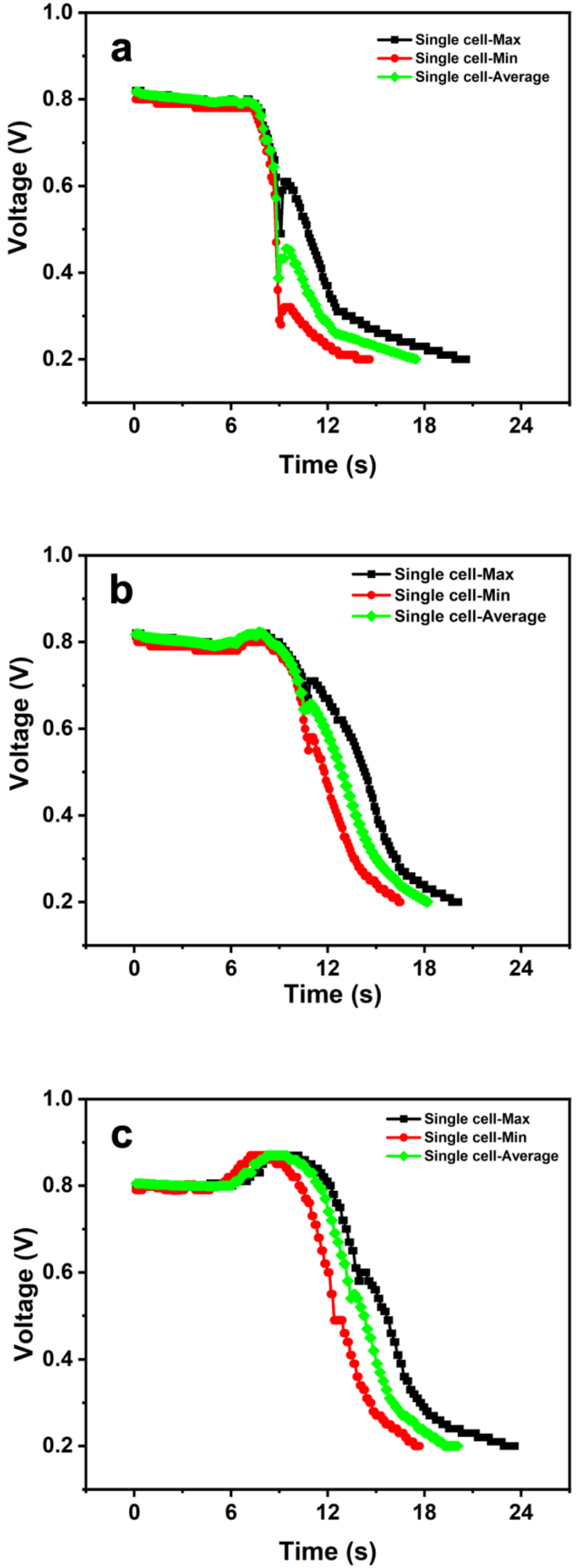

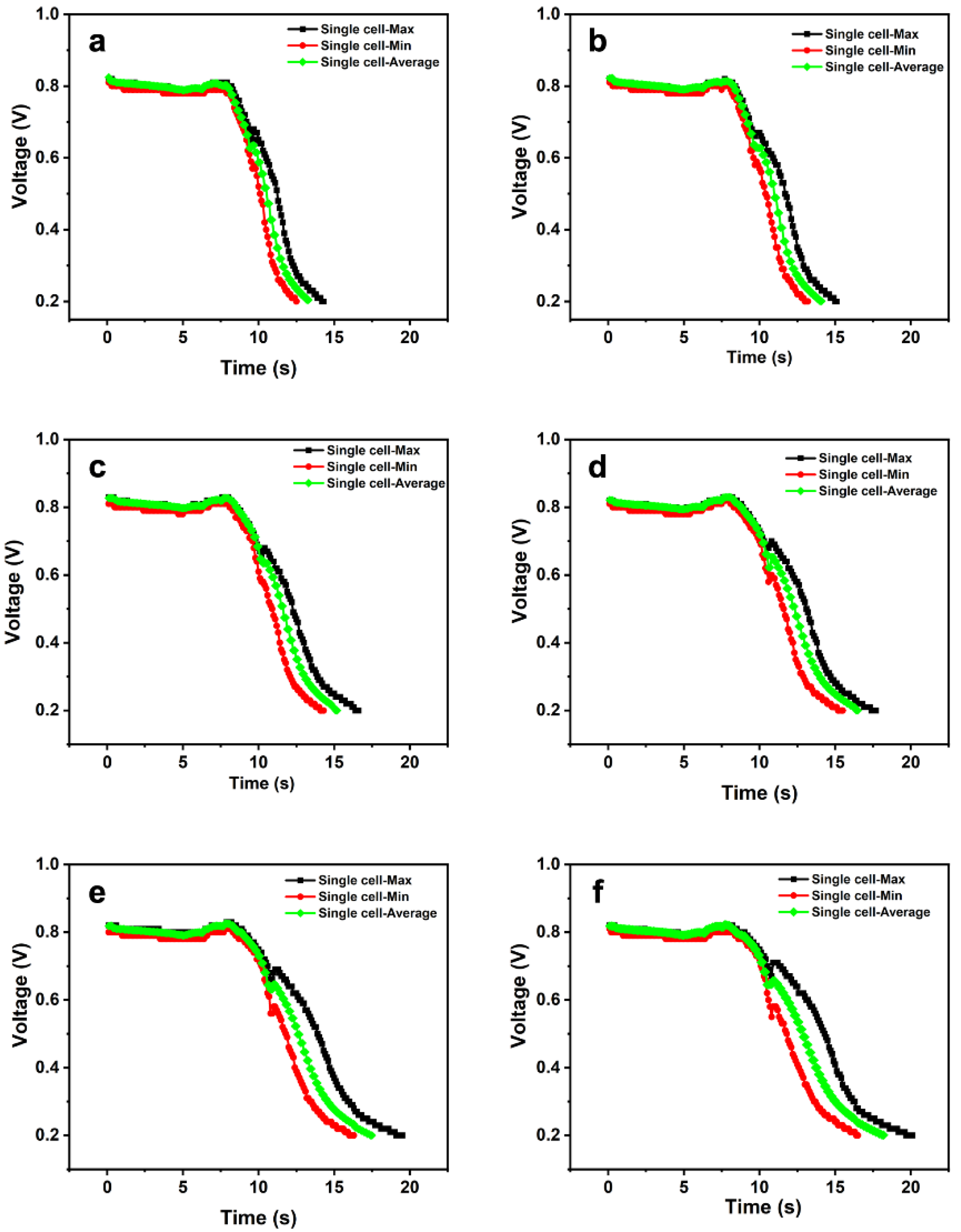

| Name | Parameters |
|---|---|
| Type | 9 ssl |
| Single-cell number | 135 |
| Active area | 285 cm2 |
| Hydrogen/air stoichiometry | 1.5/2 |
| Working temperature | 60 °C |
| Working relative humidity | 100% |
| Cooling type | Liquid-cooled |
| Maximum power | 27 kW |
| Bipolar plate | Graphite |
| Flow field | Cocurrent flow |
| Name | Parameters |
|---|---|
| Current of the PEMFC stack | 0~300 A |
| Voltage of the PEMFC stack | 0~130 V |
| Flow rate of the hydrogen | 0~500 SLPM |
| Relative humidity of the hydrogen | 40~100% |
| Pressure of the hydrogen | 0~160 kPa.a |
| Flow rate of the air | 0~1500 SLPM |
| Pressure of the air | 0~150 kPa.a |
| Relative humidity of the air | 40~100% |
| Flow rate of coolant | 0~50 SLPM |
| Temperature of coolant | 60~65 °C |
| Protection voltage of DCDC | 20 V |
| Case No. | Auxiliary Load Resistance (Ω) | Current Drop Rate (A/s) |
|---|---|---|
| 1 | - | - |
| 2 | 150 | 10 |
| 3 | 150 | 5 |
| 4 | 150 | 7 |
| 5 | 50 | 7 |
| 6 | 60 | 7 |
| 7 | 80 | 7 |
| 8 | 100 | 7 |
| 9 | 120 | 7 |
| Auxiliary Load Resistance (Ω) | Shutdown Time (s) | Potential Maintenance Time above 0.82 V (s) |
|---|---|---|
| - | 18.4 | 10.9 |
| 50 | 13.5 | 0.1 |
Disclaimer/Publisher’s Note: The statements, opinions and data contained in all publications are solely those of the individual author(s) and contributor(s) and not of MDPI and/or the editor(s). MDPI and/or the editor(s) disclaim responsibility for any injury to people or property resulting from any ideas, methods, instructions or products referred to in the content. |
© 2023 by the authors. Licensee MDPI, Basel, Switzerland. This article is an open access article distributed under the terms and conditions of the Creative Commons Attribution (CC BY) license (https://creativecommons.org/licenses/by/4.0/).
Share and Cite
Fan, J.; Yang, Y.; Ma, T.; Zhu, D.; Xu, X. Investigation on a Shutdown Control Strategy with Residual Oxygen Rapid Elimination for Proton Exchange Membrane Fuel Cell System. Energies 2023, 16, 1285. https://doi.org/10.3390/en16031285
Fan J, Yang Y, Ma T, Zhu D, Xu X. Investigation on a Shutdown Control Strategy with Residual Oxygen Rapid Elimination for Proton Exchange Membrane Fuel Cell System. Energies. 2023; 16(3):1285. https://doi.org/10.3390/en16031285
Chicago/Turabian StyleFan, Jing, Yanbo Yang, Tiancai Ma, Dong Zhu, and Xinru Xu. 2023. "Investigation on a Shutdown Control Strategy with Residual Oxygen Rapid Elimination for Proton Exchange Membrane Fuel Cell System" Energies 16, no. 3: 1285. https://doi.org/10.3390/en16031285
APA StyleFan, J., Yang, Y., Ma, T., Zhu, D., & Xu, X. (2023). Investigation on a Shutdown Control Strategy with Residual Oxygen Rapid Elimination for Proton Exchange Membrane Fuel Cell System. Energies, 16(3), 1285. https://doi.org/10.3390/en16031285







